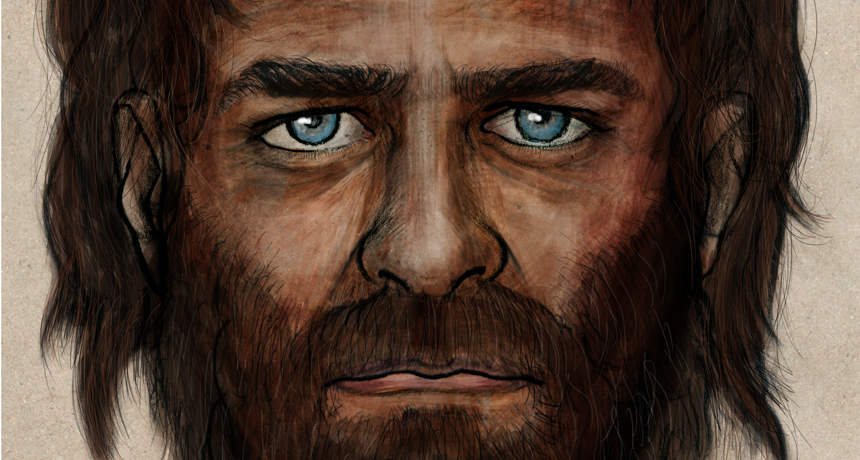Blue eyes in the Stone Age
Genes from an ancient skeleton suggest that dark-skinned people may have been the first to evolve blue eyes

This is an artist’s educated guess as to what La Braña 1 might have looked like.
Carles Lalueza-Fox, Institute of Evolutionary Biology (CSIC-UPF)
Blue eyes may have evolved before blond hair and pale skin. That’s the conclusion of a new study. It analyzed genes from a 7,000-year-old Spanish skeleton.
That skeleton came from a Stone Age man. Scientists discovered the hunter-gatherer’s remains in 2006. They found it in a cave in northwestern Spain. The site is known as La Braña-Arintero, so scientists refer to the man as La Braña 1. DNA from one of his teeth shows that he would have been genetically different from most present-day Europeans. Carles Lalueza-Fox of the Institute of Evolutionary Biology in Barcelona and colleagues reported their findings January 26 in Nature.
This man was lactose intolerant. That means he would not have been able to digest milk easily, at least as an adult. He also carried few copies of genes needed to break down starch. These are further clues suggesting that being able to digest milk and starch probably evolved after the beginnings of agriculture. That’s when communities settled down, began planting food and started tending livestock.
La Braña 1’s DNA indicates that his eyes were blue (or at least not brown, which had been common in early humans). The man’s pigment genes indicate that his hair and skin were dark. These data suggest that light-colored skin had not yet become the norm throughout Europe by the Stone Age.
Power Words
agriculture The growth of plants, animals or fungi for human needs, including food, fuel, chemicals and medicine.
DNA (short for deoxyribonucleic acid) A long, spiral-shaped molecule inside most living cells that carries genetic instructions. In all living things, from plants and animals to microbes, these instructions tell cells which molecules to make.
evolutionary biology The study of adaptive processes that have led to the diversity of life on Earth. Scientists who work in this field can study many different subjects, including the microbiology and genetics of living organisms, how species change to adapt, and the fossil record (to assess how various ancient species are related to each other and to modern-day relatives).
gene A segment of DNA that codes, or holds instructions, for producing a protein. Offspring inherit genes from their parents. Genes influence how an organism looks and behaves.
hunter-gather A cultural group that feeds itself through hunting, fishing and gathering wild produce (such as nuts, seeds, fruits, leaves, roots and other edible plant parts). They can be somewhat nomadic and do not rely on agriculture for their foodstuffs.
lactose A type of sugar found in milk and other dairy products.
lactose intolerance An inability to easily digest lactose, a sugar found in milk and other dairy products. People with this condition do not produce an enzyme (or enough of this enzyme) to break lactose down into two simpler sugars: glucose and galactose. These are more readily absorbed into the bloodstream for use in cells. The condition generally does not occur until after age 2. People — especially adults — that make too little of the enzyme lactase may develop abdominal pain, gas, bloating and diarrhea shortly after eating foods containing relatively large amounts of lactose.
pigment A material, like the natural colorings in skin, that alter the light reflected off of an object or transmitted through it. The overall color of a pigment typically depends on which wavelengths of visible light it absorbs and which ones it reflects. For example, a red pigment tends to reflect red wavelengths of light very well and typically absorbs other colors. Pigment also is the term for chemicals that manufacturers use to tint paint.
starch A type of carbohydrate that exists as a polymer — a chain of repeating subunits. About one-quarter of starch consists of amylose; roughly three-quarters is amylopectin.
Stone Age An early period in human history that was characterized by the creation and use of stone tools.







